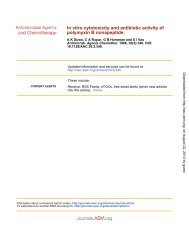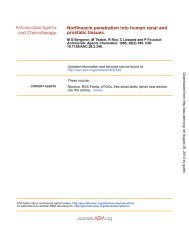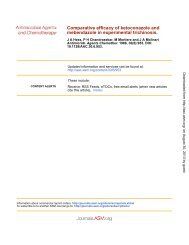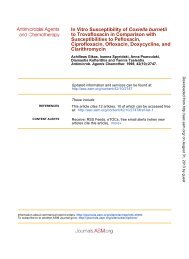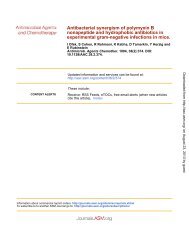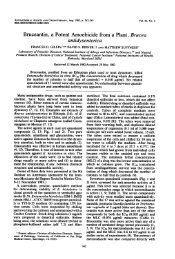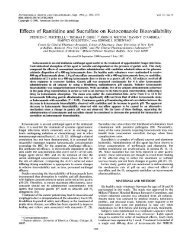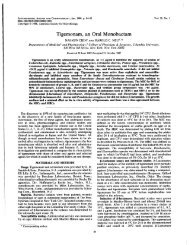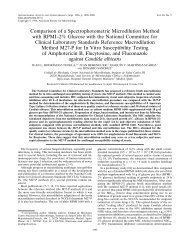Pharmacokinetics of Piperacillin-Tazobactam in Anuric Intensive ...
Pharmacokinetics of Piperacillin-Tazobactam in Anuric Intensive ...
Pharmacokinetics of Piperacillin-Tazobactam in Anuric Intensive ...
Create successful ePaper yourself
Turn your PDF publications into a flip-book with our unique Google optimized e-Paper software.
ANTIMICROBIAL AGENTS AND CHEMOTHERAPY, May 2002, p. 1557–1560 Vol. 46, No. 5<br />
0066-4804/02/$04.000 DOI: 10.1128/AAC.46.5.1557–1560.2002<br />
Copyright © 2002, American Society for Microbiology. All Rights Reserved.<br />
<strong>Pharmacok<strong>in</strong>etics</strong> <strong>of</strong> <strong>Piperacill<strong>in</strong></strong>-<strong>Tazobactam</strong> <strong>in</strong> <strong>Anuric</strong> <strong>Intensive</strong> Care<br />
Patients dur<strong>in</strong>g Cont<strong>in</strong>uous Venovenous Hemodialysis<br />
Silke C. Mueller, 1 * Jolanta Majcher-Peszynska, 1 Heiko Hickste<strong>in</strong>, 2 Astrid Francke, 3 Annette Pertschy, 4<br />
Mart<strong>in</strong> Schulz, 2 Ralf Mundkowski, 1 and Bernd Drewelow 1<br />
Department <strong>of</strong> Cl<strong>in</strong>ical Pharmacology, Institute <strong>of</strong> Experimental and Cl<strong>in</strong>ical Pharmacology and Toxicology, 1 Cl<strong>in</strong>ic for Internal<br />
Medic<strong>in</strong>e, 2 Cl<strong>in</strong>ic for Anesthesiology and <strong>Intensive</strong> Care Medic<strong>in</strong>e, 3 and Cl<strong>in</strong>ic for Surgery, 4<br />
University <strong>of</strong> Rostock, D-18057 Rostock, Germany<br />
Received 16 January 2001/Returned for modification 15 July 2001/Accepted 25 January 2002<br />
The pharmacok<strong>in</strong>etics <strong>of</strong> piperacill<strong>in</strong>-tazobactam were <strong>in</strong>vestigated <strong>in</strong> eight anuric <strong>in</strong>tensive care patients<br />
treated by cont<strong>in</strong>uous venovenous hemodialysis (CVVHD). The elim<strong>in</strong>ation half-life <strong>of</strong> piperacill<strong>in</strong> was 4.3 <br />
1.2 h, and that <strong>of</strong> tazobactam was 5.6 1.3 h. The contribution <strong>of</strong> CVVHD to the overall elim<strong>in</strong>ation was<br />
relevant (>25%) for both drugs.<br />
<strong>Piperacill<strong>in</strong></strong>-tazobactam is a -lactam–-lactamase <strong>in</strong>hibitor<br />
comb<strong>in</strong>ation with a broad spectrum <strong>of</strong> antibacterial activity<br />
aga<strong>in</strong>st gram-positive as well as gram-negative pathogens. It is<br />
frequently used for the empirical treatment <strong>of</strong> <strong>in</strong>fection <strong>in</strong><br />
<strong>in</strong>tensive care patients (2, 15). The aim <strong>of</strong> this <strong>in</strong>vestigation was<br />
to determ<strong>in</strong>e the pharmacok<strong>in</strong>etics <strong>of</strong> piperacill<strong>in</strong>-tazobactam<br />
<strong>in</strong> critically ill patients with acute anuric renal failure treated by<br />
cont<strong>in</strong>uous venovenous hemodialysis (CVVHD).<br />
Eight critically ill patients were <strong>in</strong>cluded <strong>in</strong> the <strong>in</strong>vestigation<br />
(Table 1). Inclusion criteria were an age <strong>of</strong> 18 years, acute renal<br />
failure treated by CVVHD, anuria (100 ml <strong>of</strong> ur<strong>in</strong>e/day), and<br />
treatment with piperacill<strong>in</strong>-tazobactam. Patients with severe liver<br />
failure or cholestasis were excluded. The protocol <strong>of</strong> the study was<br />
approved by the local ethical committee, and <strong>in</strong>formed consent<br />
was obta<strong>in</strong>ed from a first-degree relative. CVVHD was performed<br />
with an AN69 hollow-fiber dialyzer (Multiflow 60; Hospal,<br />
Nuremberg, Germany) under the follow<strong>in</strong>g conditions: a<br />
blood flow rate <strong>of</strong> 150 ml/m<strong>in</strong>, a dialysate flow rate <strong>of</strong> 1.5 liters/h,<br />
and an ultrafiltrate flow rate <strong>of</strong> 80 to 200 ml/h. Doses <strong>of</strong> piperacill<strong>in</strong>-tazobactam<br />
(4.5 g <strong>of</strong> Tazobac; Wyeth-Lederle) and dos<strong>in</strong>g<br />
schedules were chosen empirically by the attend<strong>in</strong>g physicians<br />
(Table 2). <strong>Piperacill<strong>in</strong></strong>-tazobactam was adm<strong>in</strong>istered <strong>in</strong>travenously<br />
over 15 m<strong>in</strong>. Correspond<strong>in</strong>g predialyzer blood samples<br />
and dialyzer-outlet dialysate samples were taken before drug adm<strong>in</strong>istration,<br />
at 10 and 30 m<strong>in</strong> after <strong>in</strong>fusion, and at 1, 2, 4, 6, 8,<br />
12, 20, 22, and 24 h after <strong>in</strong>fusion. Sampl<strong>in</strong>g was performed <strong>in</strong> the<br />
first dosage <strong>in</strong>terval after the dialyzer membrane was changed.<br />
Blood samples were centrifuged immediately after they were<br />
taken, and plasma and dialysate samples were frozen at 80°C<br />
until analysis. The concentrations <strong>of</strong> piperacill<strong>in</strong> and tazobactam<br />
were determ<strong>in</strong>ed by reversed-phase high-performance liquid<br />
chromatography with UV detection, with modification <strong>of</strong> the<br />
methods reported previously (13, 16). Plasma specimens were<br />
deprote<strong>in</strong>ated, and dialysate was used without pretreatment. The<br />
presence <strong>of</strong> piperacill<strong>in</strong> was determ<strong>in</strong>ed from the water layer<br />
* Correspond<strong>in</strong>g author. Mail<strong>in</strong>g address: Institute <strong>of</strong> Experimental<br />
and Cl<strong>in</strong>ical Pharmacology and Toxicology, Department <strong>of</strong> Cl<strong>in</strong>ical Pharmacology,<br />
University <strong>of</strong> Rostock, Schill<strong>in</strong>gallee 70, D-18057 Rostock,<br />
Germany. Phone: 49-381-494-5959. Fax: 49-381-494-5782. E-mail:<br />
silke.mueller@med.uni-rostock.de.<br />
extracted with dichloromethane; tazobactam samples were derivatized<br />
with 1,2,3-triazole and <strong>in</strong>jected without extraction. The<br />
chromatographic conditions for piperacill<strong>in</strong> were as follows: a<br />
guarded Nucleosil C 18 100-5/250 4 column, an eluent <strong>of</strong> methanol-KH<br />
2 PO 4 (1:1, vol/vol; 67 mM; pH 3), ambient temperature,<br />
a flow rate <strong>of</strong> 0.5 ml/m<strong>in</strong>, a <strong>of</strong> 214 nm, and a retention time <strong>of</strong><br />
20 m<strong>in</strong>. The chromatographic conditions for tazobactam were<br />
as follows: a Superspher C 18 100-5/250 4 column; an eluent <strong>of</strong><br />
acetonitrile-Na 2 HPO 4 (1:3, vol/vol; 1 mM), NaH 2 PO 4 (1 mM),<br />
and tetrabutylammoniumbromide (5 mM) (pH 3); a temperature<br />
<strong>of</strong> 40°C; a flow rate <strong>of</strong> 0.5 ml/m<strong>in</strong>; a <strong>of</strong> 326 nm; and a retention<br />
time <strong>of</strong> 6 m<strong>in</strong>. The assay was calibrated over a l<strong>in</strong>ear concentration<br />
range <strong>of</strong> 5 to 100 mg/liter and validated at 5, 10, and 100<br />
mg/liter (19). In each matrix (plasma and dialysate), the limit <strong>of</strong><br />
quantification for both substances was below 1 mg/liter; the <strong>in</strong>traday<br />
and <strong>in</strong>terday coefficients <strong>of</strong> variation (n 5) did not exceed<br />
5 and 9% for piperacill<strong>in</strong> and 4 and 8% for tazobactam,<br />
respectively; accuracies were between 97 and 107%.<br />
Concentration time data for piperacill<strong>in</strong> and tazobactam<br />
were analyzed with Topfit 2.0 (5). By nonl<strong>in</strong>ear least-square<br />
regression analysis, plasma samples were best fitted to an open<br />
one-compartment model. The Akaike <strong>in</strong>formation criterion<br />
was used for the selection <strong>of</strong> the model and determ<strong>in</strong>ation <strong>of</strong><br />
the best fit. The estimated values from the fitted model were<br />
used to derive the volume <strong>of</strong> distribution (V), the elim<strong>in</strong>ation<br />
half-life (t 1/2 ), the total body clearance (CL total ), and rate<br />
constants (e.g., the elim<strong>in</strong>ation rate constant). The plasma and<br />
dialysate areas under the curve (AUCs) were determ<strong>in</strong>ed from<br />
the first to the last data po<strong>in</strong>t by the l<strong>in</strong>ear trapezoidal method.<br />
The CL via CVVHD (CL CVVHD ) was calculated by the<br />
equation CL CVVHD (AUC dialysate dialysate flow rate)/<br />
AUC plasma , where AUC dialysate dialysate flow rate describes<br />
the amount <strong>of</strong> drug elim<strong>in</strong>ated <strong>in</strong>to the dialysate (6, 9, 20). The<br />
saturation coefficient (SC) was determ<strong>in</strong>ed by the equation SC<br />
AUC dialysate /AUC plasma (9). The fraction <strong>of</strong> the elim<strong>in</strong>ation<br />
by CVVHD (F CVVHD ) was determ<strong>in</strong>ed by the equation<br />
F CVVHD (CL CVVHD /CL total ) 100 (17). With the <strong>in</strong>dividual<br />
pharmacok<strong>in</strong>etic parameters obta<strong>in</strong>ed, steady-state peak and<br />
trough plasma concentrations for a simulated dosage regimen<br />
were calculated with<strong>in</strong> the given model. These were used to<br />
Downloaded from http://aac.asm.org/ on August 30, 2013 by guest<br />
1557




